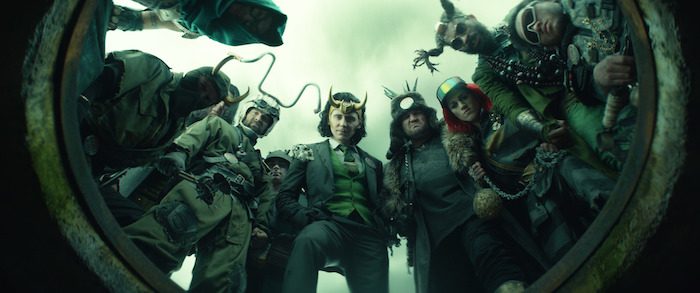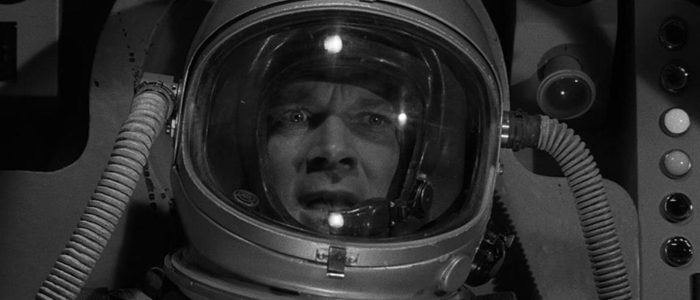
Look, I get it — multiverse storytelling can be confusing. Marvel’s Loki streaming series is only the latest in a long line of stories that plays fast and loose with the idea of multiple or parallel timelines. Loki follows the God of Mischief (Tom Hiddleston) after he gets involved with the Time Variance Authority, or the TVA, as they try to correct problems in individual timelines. This provides us a chance to see lots of variant Lokis (including our favorite chompy green boy) and opens up opportunities for a lot of zany storytelling that doesn’t necessarily have to impact the primary timeline.
The idea of multiple universes existing at the same time isn’t anything new. Some of the earliest examples date back to Norse mythology, which divided existence into nine worlds. DC Comics first introduced the idea of the DC multiverse in its comics in All Star Comics #3 in 1940, and Marvel later followed suit, starting with their What if? series in the 1970s. While the concept of parallel universes might feel a little daunting to contemplate on your own, these five television episodes will help you understand the magic of the multiverse.

“The Parallel” — The Twilight Zone
When it comes to television that changed the way we think, Rod Serling‘s The Twilight Zone is the forebear of them all. The original series ran from 1959 to 1964 and contained stories from science fiction greats like Ray Bradbury (Farhenheit 451) and Richard Matheson (I Am Legend). Each episode in the anthology series told a different short story, most with the intent of exploring some political or social allegory.
In 1963’s “The Parallel”, Major Robert Gaines (Steve Forrest) is orbiting earth in his space capsule when he suddenly blacks out and wakes up on Earth with no memory of how he got there. He’s uninjured, but the world he’s arrived in doesn’t quite match the one he left. His daughter suspects he’s someone else, his house suddenly has a white picket fence that his wife swears has always been there, and everyone keeps calling him Colonel, which matches his uniform but not his memories. He’s a little shaken until he comes to the conclusion that he’s in a parallel universe, and then takes steps to get back to his own timeline.
“The Parallel” marks the first instance of multiverse storytelling on TV. It doesn’t do anything particularly groundbreaking and is a middle-of-the-road The Twilight Zone episode, but it’s the first, which means it paved the way for everyone else to tell TV stories about parallel universes and doppelgangers.

“Mirror Mirror”/”Crossover” — Star Trek/Star Trek Deep Space Nine
Did I say doppelgangers? If there’s one franchise that has capitalized on the potential fun of meeting your alternate self, it’s Star Trek. In the “Mirror Mirror” episode of the original series, a teleporter mishap sends Kirk, McCoy, Scotty, and Uhura to a parallel dimension where everything is reversed. The Federation has become an evil Empire, Kirk is a tyrant, and Spock has a goatee (that’s how you know he’s evil). The episode started several tropes about doppelgangers (including the whole goatee thing), and paved the way for future Star Trek iterations to really go wild with the Mirror Universe.
Star Trek: Deep Space Nine explored the Mirror Universe more than any other Star Trek series, with stories taking place there over five different episodes. The first of these, “Crossover,” is the most important and sets the stage for the later mirror episodes. In “Crossover,” Major Kira (Nana Visitor) and Doctor Bashir (Alexander Siddig) have an accident inside of the wormhole near the planet Bajor, sending them to the Mirror Universe. It’s been decades since Kirk and co. crossed over, but things are still pretty backwards in the Mirrorverse. Instead of the Federation, there’s a coalition between the Klingons, Cardassians, and Bajorans. Terrans (a fancy word for Earthlings) have been enslaved. The space station Deep Space Nine is instead a mining operation, run by the alternate Kira, the Intendant.
There are few things in the world as enjoyable as watching Visitor play her double role. The entire cast really gets to go for it with their Mirrorverse personas, and you can tell they’re having a blast. The Mirror Universe in Deep Space Nine gave the actors a chance to explore their characters in new ways, and it provided more insight into their individual pathos. Sure, the Mirrorverse versions were the “evil” versions of themselves, but there were still versions of themselves. Kira is a strong leader with a dry sense of humor, regardless of whether she’s the former Bajoran freedom fighter or the Intendant. “Crossover” set up the following four Deep Space Nine Mirror episodes, including episodes where Captain Sisko (Avery Brooks) must pretend to be his doppelganger and deal with the fact that his dead wife is still very alive in the parallel universe. Some of the episodes are silly fun, and some are a bit more heady, but they all get to explore sides of these characters that we’ve never seen before.

“Remedial Chaos Theory” — Community
The NBC sitcom Community frequently made its own riffs on popular tropes, and it had an utter field day with parallel universes. In the season 3 episode, “Remedial Chaos Theory,” viewers are treated to seeing six different ways the same evening could have played out. The friends, who met in a Spanish study group at their community college, are all celebrating Troy (Donald Glover) and Abed (Danny Pudi) moving into a new apartment. When the pizza arrives, group leader Jeff (Joel McHale) suggests they roll dice to see who has to go get the pizza. Abed, who is sensitive to tropes, points out that Jeff is creating new timelines by introducing chance, and then we get to see each of them play out.
What “Remedial Chaos Theory” does is brilliant. It’s a bottle episode, all set in one location with no visible impact on the overall plot. However, by seeing how the situations change each time a single character is removed from the group dynamic, we’re able to learn so much more about the group as a whole. The episode gives us insight into the characters and their relationships by changing up the formula just a pinch and removing one element. In the Darkest Timeline, which leaves Pierce (Chevy Chase) dead and severely maims the rest of the group, it’s revealed that things fall apart without Troy in the mix. At the end of the episode, the prime timeline continues and it’s Jeff who has to go get the pizza. This ends up being the most positive of the timelines, which means maybe the group is better off without Jeff at all. It’s a great piece of character storytelling and even ends with the Darkest Timeline versions of Troy and Abed making felt goatees for themselves before declaring they are Evil Troy and Evil Abed.

“Rixty Minutes” – Rick and Morty
Community showrunner Dan Harmon clearly has a love for stories involving parallel timelines, so it’s no surprise that he expanded on those ideas in Rick and Morty, the adult animated series he developed with Justin Roiland. Rick and Morty is a kind of Back to the Future for twisted adults; it follows the adventures of alcoholic mad scientist Rick Sanchez (Roiland) and his hapless grandson Morty Smith (also Roiland) as they travel through space and time. In the first season episode “Rixty Minutes,” Rick introduces the entire Smith family to the many parallel timelines that exist. He and Morty watch Interdimensional Cable in the A plot, which gives Roiland a chance for lots of fun improvisational gags, but the B plot is more interesting. In order to enjoy his cable watching, Rick gives Morty’s parents and sister a helmet that will let them see through the eyes of some of their alternate selves.
Jerry (Chris Parnell) finds a version of himself that’s a huge Hollywood player who parties with Johnny Depp. Beth (Sarah Chalke) finds a reality where she’s not a horse surgeon, but a human surgeon, like she always wanted. Their teenage daughter Summer (Spencer Grammar) discovers that she was an unplanned pregnancy and that her parents argued about whether or not to get an abortion. In the parallel universes, she either doesn’t exist or her life is hopelessly boring. This leads to a pretty massive existential crisis, but she’s stopped by Morty, who has already had his fair share of timey-wimey weirdness.
Morty takes Summer upstairs and shows her two dirt mounds in the backyard. He explains that he’s not the Morty from this timeline, and that he and Rick had to come here after things in their timeline got too bad. The Rick and Morty in this timeline had just died, so they slipped in unnoticed. Then, Morty gives Summer a bit of advice that shows he’s beginning to grow up a bit on his madcap adventures.
“Nobody exists on purpose. Nobody belongs anywhere. Everybody’s gonna die. Come watch TV?” he pleads.
The episode ends with the entire Smith family realizing that dwelling on possible alternate realities will only ever cause problems. It’s a testament to living in the here and now, and is one of the series’ most emotionally resounding moments.
There are dozens of shows with multiverse stories out there, from ’90s sci-fi staple Sliders to the later seasons of Supernatural. These five, however, helped expand upon the trope as a whole, and are worth checking out to improve your pop culture savvy. That, and they’re just a lot of fun.
The post What is the Multiverse? Five Must-See Alternate Timeline TV Episodes to Watch After ‘Loki’ appeared first on /Film.
0 Comments